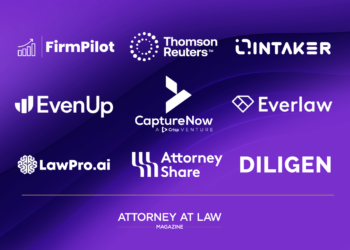I’ve been writing about legal AI since 2019. While machine learning and Natural Language Processing (NLP) have been around for years, there has been nothing that would do more than low level tasks like doc review and near template-based contract generation. Until now.
Make no mistake about it, Generative AI like Chat GPT, Bard etc. is the biggest tech breakthrough in our lifetime.
Allen & Overy, a global legal powerhouse with over 3,000 attorneys announced their collaboration with OpenAI to create Harvey, a Chat GPT powered generative AI developed specifically for the legal profession.
Harvey is an absolute game changer that can work in over 20 languages simultaneously. It is also now offering its product to other firms who must join a waitlist to get it.
How big is it? It will indeed replace lawyers, accountants, compliance professionals, recruiters and other high-end professionals. Not all of them but the profession is about to be turned on its head. According to a study by Goldman Sachs, AI will be able to replace humans in up to 44% of all legal tasks performed in the future.
AI has done legal research and completed doc review thousands of times faster and more efficiently than humans. In a December 2022 experiment, AI rendered a judgement that the experimenters concluded “showed a more developed moral sense than the Supreme Court”
I’ve had dozens of lawyers ask me legal questions ranging from general to highly esoteric.
What has happened? The overwhelming majority of the time, Chat GPT was correct. Whether it was changes to RESPA or a cost benefit analysis on renewing a patent, Chat got it right.
Yes, in a few instances, it was wrong. For example, one attorney asked me a question about whether punitive damages could be collected in a certain situation. While the law stated it’s possible, the decades of experience my friend had in the trenches, made clear they’re never actually awarded. This is why the key to using AI is Human Eyes Failsafe (HEF).
But let’s be clear. Generative and legal-specific AI is going to wipe out millions of billable hours by next year. It is going to eliminate tens of thousands of paralegal, legal assistant jobs. It will do everything from doc review to trial and settlement strategy to M&A Predictive Analysis.
Here are just a few examples of Legal AI that haven’t been the cause celebre’ that Chat GPT has been, but which will impact the legal profession.
Say Goodbye to Millions of Billable Hours
Jake Heller, the CEO and Co-Founder at CaseText, has a product he’s very excited about. CoCounsel is an AI legal assistant (and more) that is powered by Chat GPT 4 and which makes all other TAR (Technology Assisted Review) pale by comparison. It does a multitude of other tasks, as well.
“CoCounsel already performs several functions typically undertaken by paralegals, such as document review, document summarization, and database searches, and more CoCounsel skills designed to streamline routine drafting and similar tasks are already in development.
“CoCounsel’s Extract Contract Data skill enables a company to ask CoCounsel a question—e.g., to find and sort all change of control clauses or issues in an uploaded set of contracts. CoCounsel will identify a list of relevant contract clauses from every contract and extract exact language from contracts to support its response.”
He went on to describe how it can help in-house counsel.
“Our in-house customers span a broad range of companies across nonprofit, public and private sectors, including the automotive, software, healthcare, real estate, professional services, and education industries.
“In-house departments can also perform labor-intensive work such as document review themselves, faster and for less spend. CoCounsel can, for example, review millions of documents overnight, and is remarkable not just for its speed but its ability to increase work quality and accuracy, leaving no detail at risk of being missed due to human error.”
Their clients are nothing less than thrilled with that and the myriad other functions CoCounsel can do.
On March 14, 2023, Darth Vaughn, the litigation counsel and legal innovation & technology operations lead at Ford Motor Company stated, “This technology has the potential to revolutionize the way lawyers practice. The value of CoCounsel is quickly becoming evident across a range of our practice groups.”
Let’s do the math. It would take at least 600 billable hours to review five million pages with the help of the best previous TAR tech. Multiply that 600 hours times an average rate of $500 per attorney and the client is billed over $300,000 for doc review.
CoCounsel’s AI can do that number of pages in one night.
Where is this going? Heller has a clear vision.
“Over the next few years, AI will be able to accomplish highly complex, multi-step tasks on behalf of lawyers. Attorneys and legal professionals will simply describe what they’d like done, and the AI will understand which tools and processes it needs to execute the project.”
The Bottom Line. If a firm is trying to gain Ford or any potential clients, they’re probably going to be asked whether they use generative AI for doc review. If the answer isn’t yes, they’re probably not going to get the client. If their current clients ask them the same question, they’re probably on the verge of losing that client to a firm that does.
Alexa, Please Draft a Patent for Me…
Can AI draft and prosecute a complete patent? Not yet. But it can do some very serious heavy lifting i.e., claim support. Jack Xu, a former patent prosecution attorney and the CEO of PatentPal described what his AI does for clients.
“At a high level, the tool generates claim support. We think about a patent application as having three layers: (1) A set of claims describing the core IP, (2) description that directly support the claims, i.e., claim support, and (3) additional context that provides ‘enablement,’ i.e., provides enough context so that someone else can reconstruct the invention.”
PatentPal currently generates that second layer. Altogether, the tool generates about three to six hours of mechanical writing for a typical patent application. This is roughly 50% of a provisional application or 20-30% of a full utility application.
Specifically, what the tool generates includes the following:
- Abstract section
- Brief summary section
- Flowcharts to support method claims
- Block diagrams to support system and device claims (or any “thing” that is not a method)*
- Brief descriptions and detailed descriptions of all the figures it generates.
*By default it generates block diagrams for device claims, but there is also a way to use the tool to work with inventor illustrations.
“The generated content addresses the written disclosure requirement under section 112, which prevents an inventor from claiming as their IP what they have not disclosed in their specification,” Xu says. “In practice, patent attorneys would need to produce a lot of mechanical writing to recite claimed elements in prose form in the specification, e.g., ‘embodiments may include a first element, etc…’ This is not hard to do, but it is nevertheless laborious.”
I asked Xu about the future of AI that will do patent prosecution.
“It’s technically feasible to get to 60% automation on a typical case given current technology. And as large language models like GPT-4 continue to evolve, I imagine we can go well beyond that. This includes generating more of that layer 3 context, like the background section, and descriptions of key and alternative embodiments. There will be product features that are designed specifically for certain technical sectors like chemistry, but much of this technology can be applied to describing inventions across all sectors.”
The Bottom Line. Patent prosecution attorneys need to ask themselves some hard questions. If a client can get an application that normally costs $20,000, done just as well for $14,000 or in some cases $8,000, why would they pay the higher amount? If PatentPal can do these applications, how long will it be, before someone develops AI that can do applications for hardware, software, chemical and even biotech?
Let’s be clear. Generative AI like Chat GPT, Bard, DeepMind and all the legal-specific iterations are going to obliterate millions of billable hours and yes, jobs too.
This is Corporate Darwinism on steroids and the question isn’t whether attorneys and legal professionals will survive. The question is “Who will adapt?”
In my next article, I’ll cover two more sets of legal AI that are also going to radically disrupt the way law is practiced. One will give an almost immeasurable advantage to litigators going before a particular judge and the other is going to change depositions forever.











Comments 5
Who will adapt? Time to get started adapting.
Excellent article.
As a law student in 2023, do you think we should be worried as to the demand and availability of jobs in the future due to this?
Exceptional insights, especially on what sorts of long tasks AI will be capable of handling in a fraction of the time.
Great article and absolutely spot on. Recently, I directed a startup client (very cost conscious) to use ChatGPT to generate a rough first draft for the company’s Terms of Use. Of course, we will review it, but the client was thrilled at keeping his bill low. As attorneys, we need to become trusted advisors, use the technology advancements, and figure out how best to be value-added for our clients. That means the traditional billable hour approach will be upended.
This will definitely be a game-changer!